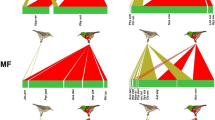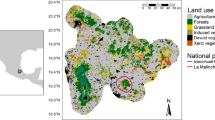Summary
Individual populations of the terrestrial isopod, Armadillidium vulgare, were studied in three Texas coastal prairie habitats: Chinese tallow forest, oak forest, and a Baccharis-grassland area. Time-specific life tables were compared for each population to determine intraspecific variation in life history parameters. Survivorship was greatest in the Baccharis area but density was lower and fluctuated less in this area than in the tallow or oak forests. Density in the oak forest was higher than in the tallow or Baccharis habitat. Density in the tallow and oak forests increased sharply during spring and summer and declined throughout the winter. Reproductive capacity of females in all three areas increased directly with body length but did not differ significantly between habitats. Density and reproductive performance of isopods in the tallow and oak forests was asynchronous with autumn leaf fall; this asynchrony may be a response to tannins leached from fallen leaves of these trees. Density and reproductive potential of isopods in the Baccharis-grassland, however, did not exhibit such marked fluctuations. Isopods in this latter habitat responded moderately to annual input of detritus during the fall.
Similar content being viewed by others
References
Al-Dabbach KY, Block W (1981) Population ecology of a terrestrial isopod in two breckland grass heaths. J Anim Ecol 50:61–77
Ayal Y, Safriel U (1979) On the misuse of life tables in determining demographic parameters of natural field populations. Bull Ecol Soc America 60:12–16
Ballanger RE (1979) Intraspecific variation in demography and life history of the lizard, Sceloporus jarrovi, along an altitudinal gradient in southeastern Arizona. Ecology 60:901–909
Birch LC (1948) The intrinsic rate of increase of an insect population. J Anim Ecol 17:15–26
Brereton J Le G (1955) A study of some factors controlling the population of some terrestrial isopods. PhD dissert., Oxford Univ., Oxford, England
Cameron GN, LaPoint TW (1978) Effects of tannins on the decomposition of Chinese tallow leaves by terrestrial and aquatic invertebrates. Oecologia (Berl.) 32:349–366
Caughley G (1977) Analysis of vertebrate populations. John Wiley and Sons, London
Cromack K (1967) Some consequences of food quality for Armadillidium vulgare populations (Isopoda: Oniscoidea). MS thesis, Univ. Texas, Austin
Deevey ES (1947) Life tables for natural populations of animals. Quart Rev Biol 22:283–314
Feeny PP (1970) Seasonal changes in oak leaf tannins and nutrients as a cuase of spring feeding by winter moth caterpillars. Ecology 51:565–581
Evans FC, Smith EF (1953) The intrinsic rate of natural increase for the human louse, Pediculus humanus (L.). Amer Nat 86:299–310
Ferguson GW, Bohlen CH, Woolley HP (1980) Sceloporus undulatus: comparative life history and regulation of a Kansas population. Ecology 61:313–322
Hubbell SP (1971) Of sowbugs and systems: the ecological bioenergetics of a terrestrial isopod. In: Patten BC (ed) Systems analysis and simulation ecology, vol 1. Academic Press, New York, p 269–324
Krebs CJ (1978) Ecology, the experimental analysis of distribution and abundance. Second edition. Harper and Row, New York
Krohne DT (1980) Intraspecific litter size variation in Microtus californicus. II. Variation between populations. Evolution 34:1174–1182
Lawlor LR (1976) Molting, growth, and reproductive strategies in the terrestrial isopod, Armadillidium vulgare. Ecology 57:1179–1194
Leslie PH, Park T (1949) The intrinsic rate of natural increase of Tribolium castaneum Herbst. Ecology 30:469–477
Leslie PH, Ranson RM (1940) The mortality, fertility and rate of natural increase of the vole (Microtus agrestis) as observed in the laboratory. J Anim Ecol 9:27–52
Leslie PH, Venables UM, Venables ISV (1952) The fertility and population structure of the brown rat (Rattus norvegicus) in corn-ricks and some other habitats. Proc Zool Soc London 122:187–238
McQueen DJ (1976a) Porcellio spinicornis Say (Isopoda) demography. II. A comparison between field and laboratory data. Canadian J Zool 54:825–842
McQueen DJ (1976b) Porcellio spinicornis Say (Isopoda) demography. III. A comparison between field data and the results of a simulation model. Canadian J Zool 54:2174–2184
McQueen DJ, Carnio JS (1974) A laboratory study of the effects of some climatic factors on the demography of the terrestrial isopod (Porcellio spinicornis Say). Canadian J Zool 52:599–611
Merriam HG (1970) Sensitivity of terrestrial isopod populations (Armadillidium) to food quality differences. Canadian J Zool 49:667–674
Mertz DB (1970) Notes on methods used in life-history studies. In: Connell JH, DB Mertz, Murdoch WW (eds) Readings in ecology and ecological genetics Harper and Row, New York, p 4–17
Miller RH (1979) A comparison of life-history strategies and environmental effects upon populations of Armadillidium vulgare in three habitats. MS thesis, Univ. Houston, Houston, Texas
Nichols JD, Conley W, Batt B, Tipton AR (1976) Temporally dynamic reproductive strategies and the concept of r- and K-selection. Amer Natur 110:995–1005
Paris OH (1963) The ecology of Armadillidium vulgare (Isopoda, Oniscoidea) in California grassland. Ecol Monogr 33:1–20
Paris OH (1965) Vagility of P32-labeled isopods in grassland. Ecology 46:635–648
Paris OH (1969) The function of soil fauna in grassland ecosystems. In: Dix RL, Beidleman RG (eds) The grassland ecosystem: a preliminary synthesis. Range Science Dept, Science Series No. 2, Colorado State University, p 331–360
Paris OH, Pitelka FA (1962) Population characteristics of the terrestrial isopod Armadillidium vulgare in California grassland. Ecology 43:229–248
Pianka ER (1978) Evolutionary ecology. Second edition. Harper and Row, New York
Randolph JC (1968) The effects of density and the relationship to cover in Armadillidium vulgare populations (Isopoda: Oniscoidea). MS thesis, Univ. Texas, Austin
Rhoades DF (1971) Evolution of plant chemical defense against herbivores. In: Rosenthal GA, Janzen DH (eds) Herbivores: Their interaction with secondary plant metabolites. Academic Press, New York, p 3–54
Saito S (1969) Energetics of isopod populations in a forest of central Japan. Res Popul Ecol 11:229–258
Shachak M (1980) Energy allocation and life history strategy of the desert isopod H. reaumuri. Oecologia (Berl.) 45:404–413
Snedecor GW (1956) Statistical methods applied to experiments in agriculture and biology. Iowa St. Univ. Press, Ames
Sorensen EMB, Burkett RD (1977) A population study of the isopod. Armadillidium vulgare, in northeastern Texas. Southwest Nat 22:375–388
Stearns SC (1976) Life-history tactics: a review of the ideas. Quart Rev Biol 51:3–47
Stearns SC (1977) The evolution of life history traits: a critique of the theory and a review of the data. Ann Rev Ecol Syst 8:145–171
Sutton SL (1972) Woodlice. Ginn and Co., Ltd., London
Author information
Authors and Affiliations
Rights and permissions
About this article
Cite this article
Miller, R.H., Cameron, G.N. Intraspecific variation of life history parameters in the terrestrial isopod, Armadillidium vulgare . Oecologia 57, 216–226 (1983). https://doi.org/10.1007/BF00379583
Received:
Issue Date:
DOI: https://doi.org/10.1007/BF00379583




